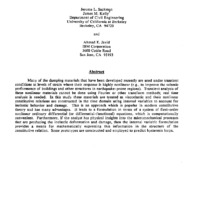-
Title
-
Constitutive Modeling of Nonlinear Damping Materials
-
Description
-
Many of the damping materials that have been developed recently are used under transient conditions at levels of strain where their response is highly nonlinear (e.g., to improve the seismic performance of buildings and other structures in earthquake-prone regions). Transient analysis of these nonlinear materials cannot be done using Fourier or other transform methods; real time analysis is needed. In this study these materials are treated as viscoelastic and their nonlinear constitutive relations are constructed in the time domain using internal variables to account for inelastic behavior and damage. This is an approach which is popular in modern constitutive theory and has many advantages. It leads to a formulation in terms of a system of first-order nonlinear ordinary differential (or differential-functional) equations, which is computationally convenient. Furthermore, if the analyst has physical insights into the micromechanical processes that are producing the inelastic deformation and damage, then the internal variable formulation provides a means for mathematically expressing this information in the structure of the constitutive relation. Some prototypes are constructed and employed to predict hysteresis loops.
-
Creator
-
Sackman, Jerome L.
-
Javid, Ahmad E.
-
Publisher
-
Wright-Patterson Air Force Base, OH : Wright Laboratory, Flight Dynamics Directorate, Air Force Systems Command
-
Date
-
1991
-
Format
-
1 online resource (15 pages) : ill.
-
Type
-
article
-
Abstract
-
Many of the damping materials that have been developed recently are used under transient conditions at levels of strain where their response is highly nonlinear (e.g., to improve the seismic performance of buildings and other structures in earthquake-prone regions). Transient analysis of these nonlinear materials cannot be done using Fourier or other transform methods; real time analysis is needed. In this study these materials are treated as viscoelastic and their nonlinear constitutive relations are constructed in the time domain using internal variables to account for inelastic behavior and damage. This is an approach which is popular in modern constitutive theory and has many advantages. It leads to a formulation in terms of a system of first-order nonlinear ordinary differential (or differential-functional) equations, which is computationally convenient. Furthermore, if the analyst has physical insights into the micromechanical processes that are producing the inelastic deformation and damage, then the internal variable formulation provides a means for mathematically expressing this information in the structure of the constitutive relation. Some prototypes are constructed and employed to predict hysteresis loops.
-
Date Issued
-
1991-08
-
Extent
-
15
-
Corporate Author
-
University of California at Berkeley
-
IBM Corporation
-
Laboratory
-
Wright Laboratory
-
Report Number
-
WL-TR-91-3078 Volume II, pages EBC-1 to EBC-15
-
DoD Project
-
2401
-
DoD Task
-
240104
-
Distribution Conflict
-
No
-
Photo Quality
-
Not Needed
-
Distribution Classification
-
1
-
Report Availability
-
Full text available
-
Index Abstract
-
Contrails only
-
Provenance
-
University of Colorado Colorado Springs, Kraemer Family Library
-
Identifier
-
ADA241312
